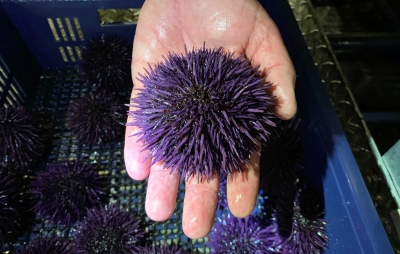
California has been in the news for all the wrong reasons. On the one side, this U.S. State has been fighting a series of wildfires that have destroyed acres of forests and displaced thousands of people. On the other, it’s facing threat from the explosion of a marine species called the purple sea urchin. These urchins have chomped off 90% of the bull kelps along the coastline of California and neighbouring State Oregon, putting the entire coastal ecosystem out of whack.
Kelps are a type of a large brown seaweed that grow in shallow, nutrient-rich saltwater, near coastal fronts around the world. They offer shelter to a host of sea creatures. The coastal water of northern California was once home to a dense coverage of kelps. But today, they have been replaced by purple sea urchins. The vast stretch of the seafloor is barren and is dotted with nothing but tens of millions of these spiny orbs.
Sea urchins are typically spiny, round creatures, inhabiting all oceans. They belong to the phylum Echinodermata – the same group or sea stars, sand dollars, sea lilies and sea cucumbers.
The purple sea urchin – Steongylocentrtus purpuratus – is voracious, kelp-eating species. They are particularly fond of bull kelps. They are native to California’s coast, and have traditionally been found in smaller numbers. But now, from California, the population of the sea urchins has spread to Oregon reef, where their count has been found to be 350 million – more than a 10,000 % increase since 2014. These millions and millions of sea urchins are eating away not just kelps but also anemones, the sponges, flesh red algae and even sand, say scientists.
Cascade of events
Sea water wasting
The trouble began in 2013, when a mysterious disease began to spread among starfish. Scientists are not sure what caused the diseases in sea stars. It wiped out tens of millions of the species. This included sunflower sea water, which is the only real predator of the purple urchin. With no predators to keep the population in check, the hitherto harmless purple sea urchins began to grow and multiply, eating everything in sight. Destruction of kelps, their primary source of food, left other creatures depended on it to starve and die. Meanwhile, purple sea urchins’ population grew 60-fold between 2014 and 2015.
Double whammy for kelps
The kelps had already been struggling because of warmer-than-usual waters in the Pacific Ocean. Warm waters are nutrient poor, and as a result, the kelp cannot grow high enough to reach the surface of the water for photosynthesis. The 2014 record-breaking heatwave and subsequent El Nino condition in 2015 fuelled their decline further.
Ecosystem collapses
As the kelps population declined, 96% of red abalone, a type of sea snail that feeds on kelp, died from starvation, by 2017. According to a study, red sea urchins, a meatier relative of purple urchins, are also declining due t lack of food kelps.
Fisheries affected
The devastation is also economic. Until recently, red abalone and red sea urchins supported a thriving commercial fishery in both California and Oregon. But the mass moralities of red abalone led to its closure in 2018. The commercial harvest of red sea urchins in California and Oregon also has taken an enormous hit.
Can kelps rebound?
- Bull kelp is one of the fastest-growing algae on Earth and if the cooler water temperatures return, the seaweed may be able to bounce back. But the excessive numbers of purple sea urchins will still pose a problem.
- The only way to restore the kelp is to remove the purple sea urchins. But to remove the ones in Oregon alone, it would take 15 to 20 years, by scientists. Without the kelps, purple sea urchins by themselves may decline. But again it could be a long wait.
- Conservationists suggest urchin farming as a solution to the problem. It involves physically removing large numbers of purple sea urchins from the seafloor to be flattened up in controlled environments for human consumption.
- However, even if the kelps rebound, it may take decades for the entire ecosystem to bounce back to its past glory.
Picture Credit : Google

